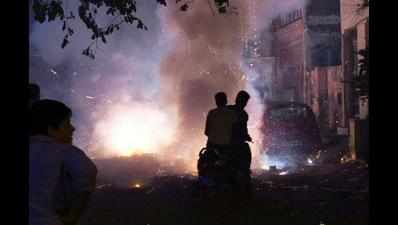- News
- City News
- bengaluru News
- A quiet Diwali sees air pollution in Bengaluru remain 'moderate'
Trending
This story is from November 1, 2016
A quiet Diwali sees air pollution in Bengaluru remain 'moderate'
graphic coming

Representative image
BENGALURU: All of two years old, Ira decided to step out of her flat in an apartment complex in Yeshwantpur to go down and meet her friends, who were busy bursting crackers. However, the smoke-filled air reverberating with the cacophonous din, and the plight of the dogs and the pigeons made her averse to crackers.
Ira is in the habit of keeping rice and water in her balcony for the pigeons.Interestingly enough, her mother, Madhurima Das, a research associate at the Indian Institute of Science (IISc), has not burst a cracker for more than a decade.
"We had a quiet Diwali. Neither I nor my spouse burst crackers. Also, being asthmatic doesn't help. Although the festival gets over, its effects linger for a while. But, I felt that the situation was a tad better this year," she said.
Across Bengaluru, a large number of citizens made a conscious choice to celebrate a quiet Deepavali.
Noting a perceptible decline in the amount of crackers burst this year, Sarita added, "We had a designated area in the building for bursting crackers. The amount of dirt there was much lesser compared to the previous years."
Concurring with the observations made by the residents, officials of the Karnataka State Pollution Control Board (KSPCB) said that pollution levels were much lesser in comparison to last year.
The National Air Quality index, which provides real-time data on air pollution indicated that particulates that could travel deep into the respiratory tract were the prominent pollutants on Sunday. Exposure to these particles could lead to short-term health problems in the eye, nose, lungs and throat.
While the maximum level of particulate matter touched 436g/m3 and the average was 11 g/ m3. On Sunday, the carbon-mono-oxide remained the major pollutant, touching 103g/ m3 in the morning. The average CO levels remained at 56g/ m3.
Particulate matter was the main pollutant in Peenya, while the air quality index (AQI) was 199 on Saturday. It remained the same on Sunday as well. PM 2.5 levels are commonly used as the best indicator of severe air pollution, while PM 10 particles are a cause of public health concern, but less lethal.
In the other air quality monitoring centres, at City Railway Station and SG Halli, particulate matter, CO and Nitrogen Dioxide were the main pollutants over the past three days.
Ira is in the habit of keeping rice and water in her balcony for the pigeons.Interestingly enough, her mother, Madhurima Das, a research associate at the Indian Institute of Science (IISc), has not burst a cracker for more than a decade.
"We had a quiet Diwali. Neither I nor my spouse burst crackers. Also, being asthmatic doesn't help. Although the festival gets over, its effects linger for a while. But, I felt that the situation was a tad better this year," she said.
Across Bengaluru, a large number of citizens made a conscious choice to celebrate a quiet Deepavali.
Sarita Gupta, a resident of Malleswaram, said, "We had a fabulous puja, which was attended by family and friends. We lit mud lamps and placed flowers everywhere in the house. We also wanted to brighten the lives of others and so sent food, sweets and clothes to an orphanage."
Noting a perceptible decline in the amount of crackers burst this year, Sarita added, "We had a designated area in the building for bursting crackers. The amount of dirt there was much lesser compared to the previous years."
Concurring with the observations made by the residents, officials of the Karnataka State Pollution Control Board (KSPCB) said that pollution levels were much lesser in comparison to last year.
The National Air Quality index, which provides real-time data on air pollution indicated that particulates that could travel deep into the respiratory tract were the prominent pollutants on Sunday. Exposure to these particles could lead to short-term health problems in the eye, nose, lungs and throat.
While the maximum level of particulate matter touched 436g/m3 and the average was 11 g/ m3. On Sunday, the carbon-mono-oxide remained the major pollutant, touching 103g/ m3 in the morning. The average CO levels remained at 56g/ m3.
Particulate matter was the main pollutant in Peenya, while the air quality index (AQI) was 199 on Saturday. It remained the same on Sunday as well. PM 2.5 levels are commonly used as the best indicator of severe air pollution, while PM 10 particles are a cause of public health concern, but less lethal.
In the other air quality monitoring centres, at City Railway Station and SG Halli, particulate matter, CO and Nitrogen Dioxide were the main pollutants over the past three days.
End of Article
FOLLOW US ON SOCIAL MEDIA










